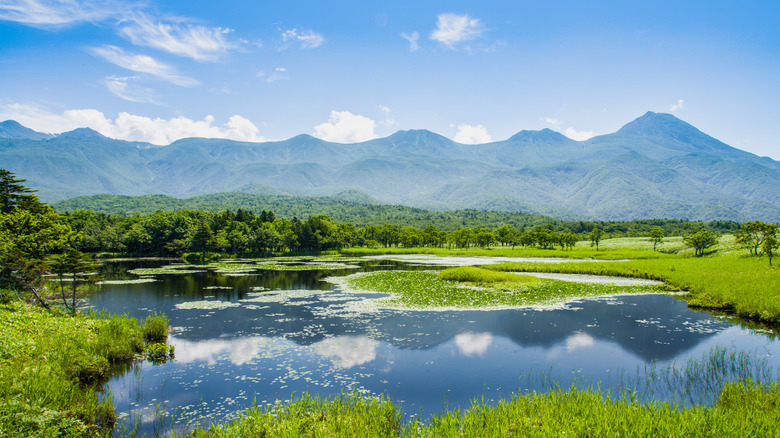Away from the bustling Harajuku district in Tokyo and the Zen temples in Kyoto is an untouched frontier that offers adventurers an opportunity to get off the beaten path and explore a different side of Japan. At the northeastern tip of Hokkaido, Japan’s northernmost island, is one of the country’s most pristine and underrated national parks: Shiretoko National Park. Designated as a UNESCO World Heritage Site in 2005, Shiretoko is known for its extraordinary biodiversity, unique visitor experiences, and expansive wilderness.
Shiretoko National Park covers an area of about 150 square miles on land and 85 square miles on the water, on a peninsula that juts out into the Sea of Okhotsk. The park is one of the most remote and unspoiled natural areas in Japan. Its name is derived from the indigenous and ancient Ainu language, where “siretok” means “end of the Earth” — a fitting title for a place that feels as remote and untouched as it does.
Wildlife enthusiasts will be thrilled to find a variety of rare and unique species in Shiretoko that are seldom seen elsewhere. Brown bears roam the dense forests, while red foxes, sika deer, and the elusive Blakiston’s fish owl make their home in this diverse habitat. The coastal areas and surrounding skies are just as lively, with seals, Steller sea eagles, and 285 bird species. Of 223 alpine plants, the Shiretoko violet, a flower that is endemic to the peninsula, blooms between late June and early July.
Experiencing Shiretoko’s natural wonders

Shiretoko has plenty of activities that allow visitors to immerse themselves in nature. Trails range from adventurous hikes to catch views of waterfalls, like Kamuiwakka River and Oshinkoshin Falls, to eight-hour treks up the peninsula’s rugged peaks, such as Mount Rausu, Shiretoko’s highest mountain. The forests and mountains surrounding the Shiretoko Goko Lakes are also a sight to behold. For those looking to explore Shiretoko’s marine environment, boat tours departing from Utoro provide a unique perspective of the peninsula’s dramatic cliffs and waterfalls that cascade directly into the sea. These tours, such as those with Gojiraiwa Kanko, also offer the chance to observe marine wildlife, including whales and dolphins.
Between February and April, the ice floes from Siberia drift to the shores of Shiretoko, bringing with them a chance to walk on drift ice while wearing a special rubber dry suit (you can even jump into the water if you dare!). MEPS provides this tour for around 5,000 yen, or $33. You can also take an icebreaker cruise with Aurora or observe the drift of ice from the shore instead.
Another one of Shiretoko’s most magical experiences is its hot springs. The outdoor hot springs are located on the east side in Rausu and on the west side in Utoro. Bathers can soak in healing waters while surrounded by the park’s serene natural beauty — a perfect way to relax after a day of exploration. Seseki Onsen in Rausu comes highly recommended.
Tips for your visit

There are several ways to get to Shiretoko National Park. One way is by train using the Japan Rail Pass — the closest station is Shiretoko Shari Station, from where you can take a bus to Utoro, the base town of the park. Another option is an eight-hour bus from Sapporo, the capital of Hokkaido. Alternatively, renting a car from Sapporo and driving to and through the park will grant maximum autonomy. Parking costs 500 yen, or around $3.30 per car. Otherwise, joining a tour might be the best option to access and explore the park.
The Shiretoko National Park Center at the park’s entrance is a good starting point. Staff will provide all the necessary information travelers may need for their adventure. Rental gear, trail maps, and resources regarding wildlife are all available here. It also has a coffee shop to perk you up before your adventure. If you plan to spend a long time in Shiretoko, you can book accommodations in Utoro or Rausu. Camping is available at locations like the Rausu Onsen Campsite.
Each season in Shiretoko unveils a different side of the park. Spring brings a burst of life as the snow melts, revealing fresh greenery and awakening wildlife from their winter slumber. Summer offers the best hiking and wildlife-watching conditions (90% encounter rates with dolphins!). Autumn transforms the landscape into a vibrant palette of reds, oranges, and yellows. Winter, though challenging, is a snow-covered wonderland with opportunities for drift-ice sightseeing. Without a doubt, Shiretoko is one of the best national parks in Japan.

